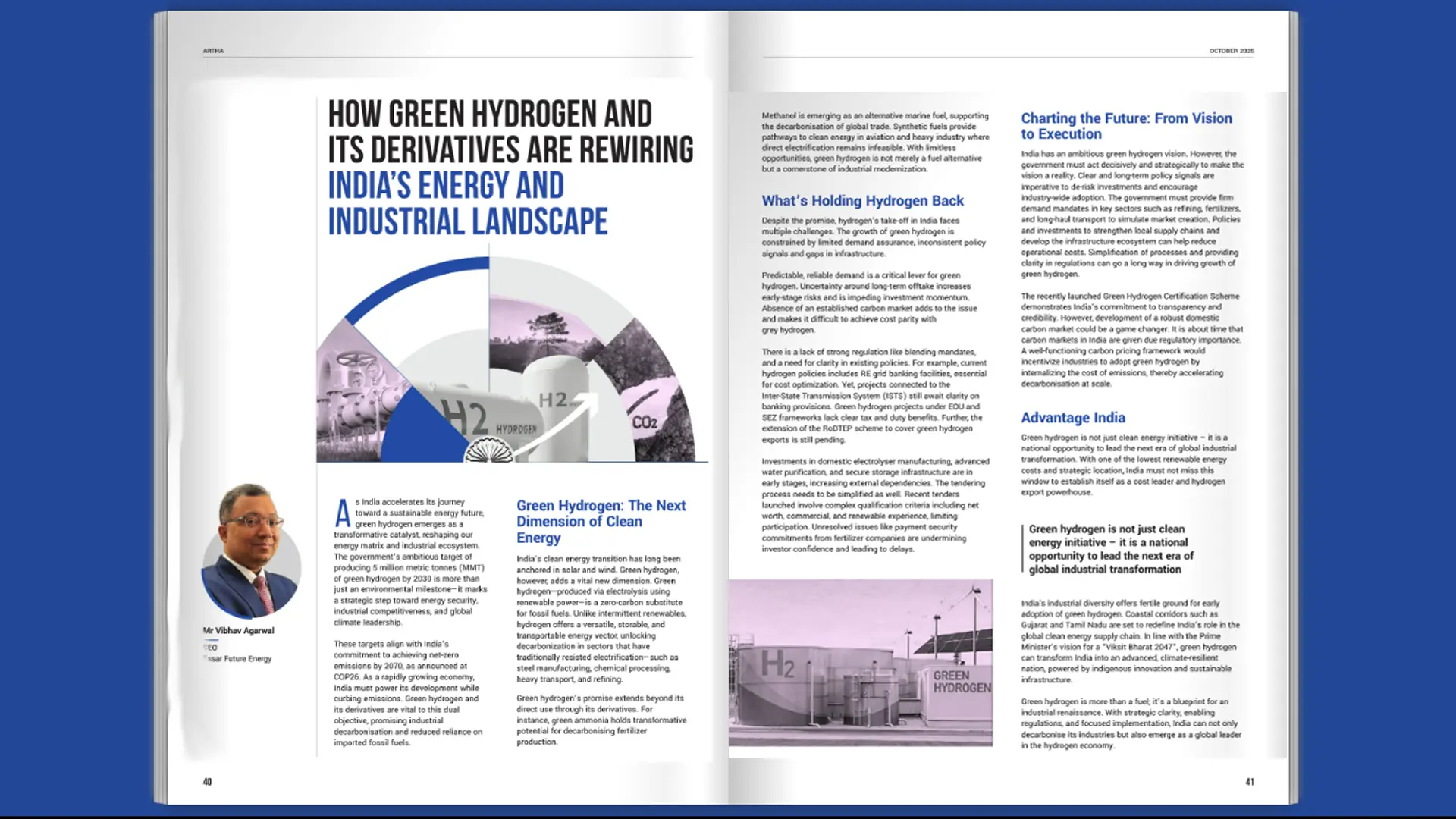An article authored by Mr Vibhav Agarwal, CEO, Essar Future Energy, published in CII ARTHA
As India accelerates its journey toward a sustainable energy future, green hydrogen emerges as a transformative catalyst, reshaping our energy matrix and industrial ecosystem. The government’s ambitious target of producing 5 million metric tonnes (MMT) of green hydrogen by 2030 is more than just an environmental milestone it marks a strategic step toward energy security, industrial competitiveness, and global climate leadership.
These targets align with India’s commitment to achieving net-zero emissions by 2070, as announced at COP26. As a rapidly growing economy, India must power its development while curbing emissions. Green hydrogen and its derivatives are vital to this dual objective, promising industrial decarbonisation and reduced reliance on imported fossil fuels.
Green Hydrogen: The Next Dimension of Clean Energy
India’s clean energy transition has long been anchored in solar and wind. Green hydrogen, however, adds a vital new dimension. Green hydrogen-produced via electrolysis using renewable power-is a zero-carbon substitute for fossil fuels. Unlike intermittent renewables, hydrogen offers a versatile, storable, and transportable energy vector, unlocking decarbonization in sectors that have traditionally resisted electrification-such as steel manufacturing, chemical processing, heavy transport, and refining.
Green hydrogen’s promise extends beyond its direct use through its derivatives. For instance, green ammonia holds transformative potential for decarbonising fertilizer production.
Methanol is emerging as an alternative marine fuel, supporting the decarbonisation of global trade. Synthetic fuels provide pathways to clean energy in aviation and heavy industry where direct electrification remains infeasible. With limitless opportunities, green hydrogen is not merely a fuel alternative but a cornerstone of industrial modernization.
What’s Holding Hydrogen Back
Despite the promise, hydrogen’s take-off in India faces multiple challenges. The growth of green hydrogen is constrained by limited demand assurance, inconsistent policy signals and gaps in infrastructure.
Predictable, reliable demand is a critical lever for green hydrogen. Uncertainty around long-term offtake increases early-stage risks and is impeding investment momentum. Absence of an established carbon market adds to the issue and makes it difficult to achieve cost parity with grey hydrogen.
There is a lack of strong regulation, like blending mandates, and a need for clarity in existing policies. For example, current hydrogen policies includes RE grid banking facilities, essential for cost optimization. Yet, projects connected to the
Inter-State Transmission System (ISTS) still awaits clarity on banking provisions. Green hydrogen projects under EDU and SEZ frameworks lack clear tax and duty benefits. Further, the extension of the RoDTEP scheme to cover green hydrogen exports is still pending.
Investments in domestic electrolyser manufacturing, advanced water purification, and secure storage infrastructure are in early stages, increasing external dependencies. The tendering process needs to be simplified as well. Recent tenders launched involve complex qualification criteria, including net worth, commercial, and renewable experience, limiting participation. Unresolved issues like payment security commitments from fertilizer companies are undermining investor confidence and leading to delays.
Charting the Future: From Vision to Execution
India has an ambitious green hydrogen vision. However, the government must act decisively and strategically to make the vision a reality. Clear and long-term policy signals are imperative to de-risk investments and encourage
industry-wide adoption. The government must provide firm demand mandates in key sectors such as refining, fertilizers, and long-haul transport to simulate market creation. Policies and investments to strengthen local supply chains and develop the infrastructure ecosystem can help reduce operational costs. Simplification of processes and providing clarity in regulations can go a long way in driving growth of green hydrogen.
The recently launched Green Hydrogen Certification Scheme demonstrates India’s commitment to transparency and credibility. However, development of a robust domestic carbon market could be a game changer. It is about time that carbon markets in India are given due regulatory importance. A well-functioning carbon pricing framework would incentivize industries to adopt green hydrogen by internalizing the cost of emissions, thereby accelerating decarbonisation at scale.
Advantage India
Green hydrogen is not just clean energy initiative—it is a national opportunity to lead the next era of global industrial transformation. With one of the lowest renewable energy costs and strategic location, India must not miss this window to establish itself as a cost leader and hydrogen export powerhouse.
Green hydrogen is not just clean energy initiative—it is a national opportunity to lead the next era of global industrial transformation
India’s industrial diversity offers fertile ground for early adoption of green hydrogen. Coastal corridors such as Gujarat and Tamil Nadu are set to redefine India’s role in the global clean energy supply chain. In line with the Prime Minister’s vision for a “Viksit Bharat 2047”, green hydrogen can transform India into an advanced, climate-resilient nation, powered by indigenous innovation and sustainable infrastructure.
Green hydrogen is more than a fuel; it’s a blueprint for an industrial renaissance. With strategic clarity, enabling regulations, and focused implementation, India can not only decarbonise its industries but also emerge as a global leader in the hydrogen economy.
Source: CII – ARTHA















































